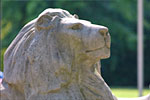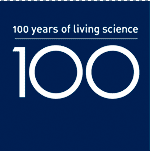Timeline
- 1845 – 1899 |
- 1900 – 1909 |
- 1910 – 1919 |
- 1920 – 1929 |
- 1930 – 1939 |
- 1940 – 1949 |
- 1950 – 1959 |
- 1960 – 1969 |
- 1970 – 1979 |
- 1980 – 1989 |
- 1990 – 1999 |
- 2000 – present
Imperial College 1930 - 1939
World
 1930 - Pluto Discovered
1930 - Pluto Discovered
In 1930 Clyde Tombaugh discovered a possible moving object on photographic plates taken on January 23 and January 29 of that year. A lesser-quality photo taken on January 20 helped confirm the movement of what became known as the nineth planet of the sun - Pluto.
In August 2006 the International Astronomical Union redefined the term “planet” and classified Pluto as a "dwarf planet."
back to top 1931 - Empire State Building Completed
1931 - Empire State Building Completed
The Empire State Building opened on May 1, 1931, becoming the tallest building in the world - standing at 1,250 feet tall.
back to top
 1936 - Hoover Dam Completed
1936 - Hoover Dam Completed
Construction on the Hoover Dam began in 1931 and was completed in 1936.
back to top
 1937 - The Hindenburg Disaster
1937 - The Hindenburg Disaster
After a three-day trip across the Atlantic from Frankfurt, Germany to New Jersey, the Hindenburg, a large, rigid airship, was in the process of landing when it broke into flames at 7:25 p.m. on May 6, 1937. Within 34 seconds, the entire airship was consumed by fire, killing 35.
back to top
 1939 - Beginning of Second World War
1939 - Beginning of Second World War
back to top
College
 1933 - Boanerges becomes the official mascot of the City & Guilds College Union after being bought for £40 in 1933
1933 - Boanerges becomes the official mascot of the City & Guilds College Union after being bought for £40 in 1933
Boanerges, or Bo’, is the official mascot of the City & Guilds College Union and is run by the City & Guilds Motor Club. The present Bo’ has been owned by the City and Guilds College since 1933 and has been maintained by students ever since.
The first Boanerges was a 1908 Rover which took part in several Brighton runs during the 1920s. However, the organisers began to realise that he shouldn't really take part because he was too young and he no longer became eligible for the run. The story of the first Boanerges' disposal is an amusing anecdote in the history of the college. He was driven to Downing Street (Ramsay Macdonald was Prime Minister), the gearboxes were promptly filled with gravel, and a well dressed dummy with a biscuit in his hand was left in the passenger seat. This was a protest against the recent knighthood of the chairman of a leading biscuit manufacturer. Apparently, the police had considerable difficulty in moving the car and so the Guilds students had proved their point. The first Boanerges was never seen again although it was becoming uneconomical to keep the car running and in a satisfactory condition.
After this event, a search was begun for a pre-1904 veteran which would be eligible for future Brighton runs. 3 enterprising Guilds students found a suitable car and the current Bo' was purchased for £40 in 1933.
Since coming to the College, Bo’ has taken part in nearly every Brighton run for the last 65 years, and finished most of them – for stories of Bo’s experiences on the run, visit http://www.cgcu.net/motor/bo/brighton.htm
Listen to a description of Bo recorded in 1957.
 1934 - Hilary Bauerman Bequest
1934 - Hilary Bauerman Bequest
A student in Metallurgy at RSM 1851-1853, and close associate of College throughout his career, even though much of it was spent abroad, Bauerman left a bequest to enable students to travel after graduation.
back to top
 1938 - Opening of the Boat House at Putney
1938 - Opening of the Boat House at Putney
The new Boathouse at Putney was opened by Lord Desborough, on 21 October 1938, designed and built by Charles Bristow. The commemorative plaque from the occasion reads, "May all who use this boathouse in it find such happiness and make such friendships as may endure throughout their lives."
 1939 - The outbreak of war
1939 - The outbreak of war
Following the declaration of war, it was decided not to take in new students to the College. However this decision was rescinded on 17th October 1939 and College re-opened. Some courses were evacuated - Metallurgy, Metallurgy Department teaching for 3rd and 4th year students transferred to Swansea but the South Kensington Department remained open to provide instruction for students of others departments, conducted by Dr. S. W. Smith. 1st and 2nd year metallurgy students remained in South Kensington.
By the 1942/3 session - the Department returned to South Kensington.
The Miners moved to Cambourne and the Biologists to their field station at Slough.
As with the First World War, many buildings were commandeered by the government and military including the Huxley Building, Henry Cole Wing, Beit, RSM and Boathouse.
back to topPeople
 1937 - Letitia Chitty (1897-1982)
1937 - Letitia Chitty (1897-1982)
During WWI, Letitia Chitty worked for the Air Ministry where she met Pippard. Inspired by him she returned to Cambridge and changed course from the mathematics to engineering, graduating with first class honours in the Mechanical Sciences Tripos in 1921, the first woman to do so.
Her career was unusual for a woman at this period. Continuing at the Air Ministry, she worked with Richard Southwell (Imperial College Rector 1942-1948) and Pippard and then joined Imperial as Research Assistant in 1934. She and Pippard worked on aircraft structures, she undertaking much of the mathematical work and on stresses in arches of the voussoir type particularly and loading of wheels. Later she undertook major work on stresses of large dams in the middle east. WWII work included research into submarine hulls under shell attack, stresses in extensible cables and pulley blocks for barrage balloons, for the Director of Scientific Research of the Admiralty and the Ministry of Supply.
Chitty became Lecturer in 1937. She retired in 1962 the 1st (of 2) Lady Fellows of Royal Aeronautical Society, the 3rd Woman Corporate Member of Institute of Civil Engineers and the 1st woman to be appointed to a technical Committee of Institute of Civil Engineers 1958. She was awarded 4 Telford Premiums for papers written in collaboration with Pippard. Besides engineering and mathematical writng she produced a book called An Alphabet of Flowers containing plant drawings and notes on her holidays. In retirement she continued to attend College and continued to work until she was over 80.
In her later years, she was even interviewed by Vogue magazine.
 Sir Ralph Freeman (1932)
Sir Ralph Freeman (1932)
Sir Ralph Freeman was the Chief Designer and Architect of the Sydney Harbour Bridge, the widest long-span bridge in the world. It is the world's largest single-arch bridge (but not the longest). The bridge was officially opened in 1932.
Freeman studied at the City and Guilds of London Institute, and in 1901 joined Douglas Fox & Partners, a firm of consulting engineers specialising in the design of steel bridges. He rose to become senior partner and in 1938 the firm changed its name to Freeman Fox & Partners. Freeman taught at Imperial College during First World War.
Another civil engineer that worked on the bridge was J. F. Pain, one of Stephen Dixon’s (Professor of Civil Engineering) students. He was awarded the Manby Premium for a paper on the Sydney Harbour Bridge. He led a group of about forty engineers working for Freeman on Sydney Harbour bridge. Among the forty were several Imperial graduates, including civil engineer Gilbert Roberts (later FRS), and his wife, Elizabeth Nada Hoira, a mathematics graduate. K. E. Hyatt was also involved in the project.
back to top Robert John Strutt, fourth Baron Rayleigh (1875-1947)
Robert John Strutt, fourth Baron Rayleigh (1875-1947)
Robert John Strutt became Chairman of the Governing Body in 1936 until his death in 1947. Strutt was a physicist as was his father J.W.S. Strutt and also like his father, was involved in psychical research, being President of the Society for Psychical Research in 1937. He became a Fellow of the Royal Society in 1905, served as Professor of Physics at Imperial College, London, from 1908 till 1919, and did valuable work on radio activity in rock formations. The rayleigh, a unit of luminous flux used to measure air glow, and the rayl a unit of, sound impedence are named after Robert John Strutt.
 Robert John Strutt, fourth Baron Rayleigh (1875-1947)
Robert John Strutt, fourth Baron Rayleigh (1875-1947)
Thompson was the first Imperial College staff member to win a Nobel Prize. Thompson introduced atomic physics to the College. He was Head of Physics Department 1930 to 1953 when he retired.
During his time at Imperial College he became interested in nuclear physics, and when the fission of uranium by neutron was discovered at the beginning of 1939 he was struck by its military and other possibilities, and persuaded the British Air Ministry to procure a ton of uranium oxide for experiments. These experiments were incomplete at the outbreak of war, when Thomson went back to the Royal Aircraft Establishment to work on a series of war problems, including magnetic mines. A year later he was made Chairman of the British Committee set up to investigate the possibilities of atomic bombs. This committee reported in 1941 that a bomb was possible, and Thomson was authorized to give this report to the American scientists Vannevar Bush and James Conant.
He spent the next year as Scientific Liaison Officer at Ottawa, and for part of this time was in close touch with the American atomic bomb effort. On returning to England he was appointed Vice-Chairman of the Radio Board and later became Scientific Adviser to the Air Ministry.
After the war he returned to work at Imperial College, and early in 1946 became interested in the possibilities of nuclear power from deuterium (heavy hydrogen). Some experiments bearing on this were started at Imperial College under Dr. Ware, but Thomson's work was theoretical. Later, because of the requirements of secrecy, this work was transferred to the Associated Electrical Industry's Research Laboratories at Aldermaston, where Thomson continued to act as Consultant.
back to top© 2007 Imperial College London

Through the first decade of the twenty-first century the campaign seeks to philanthropically raise £207 million from Imperial’s alumni, staff and friends, and donations from charitable foundations and industry.
Where your support can make a differenceGive now

We’re celebrating 100 years of living science with 100 stories. We’ve collected some of them already, and invite you to share your own stories and memories.

